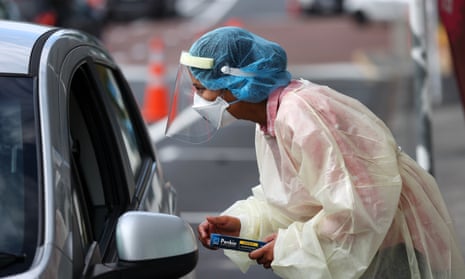New Zealand has ended its self-isolation requirements for vaccinated travellers arriving from Australia, as the country’s Covid transmission rates soar to among the highest in the world.
From Wednesday, vaccinated travellers will no longer need to self-isolate but will still be required to undergo a Covid-19 test on arrival and on day five or six, prime minister Jacinda Ardern announced on Monday.
If the traveller tests positive for the virus, they will be required to self-isolate, in line with requirements for New Zealanders. Unvaccinated travellers will still have to stay in managed isolation, or MIQ.
“I know this will be welcome news to the members of our team overseas eager to travel home to see loved ones as soon as possible. We can’t wait to see you,” Ardern said. “It’s also a huge milestone for our tourism sector and regional economies.”
The staged border reopening previously announced would still stand, but with some adjustments, she said.
The first stage, which began on Monday, now means vaccinated New Zealanders and other visa holders arriving from Australia only have to self-isolate until midnight Wednesday, when the new rules kick in. Step two, which was to allow returning New Zealanders and eligible critical workers from the rest of the world to skip isolation, was due to start from 13 March but will be brought forward to Friday. Cabinet will consider the settings for all other travellers in the coming months.
Epidemiologist Michael Baker said there was no longer much public health justification for continuing controls at the border, because “people arriving from overseas will not contribute to the disease burden”.
“We have almost got to the point now where people arriving in New Zealand have a lower prevalence of Omicron infection than people who live in New Zealand.”
New Zealand now has one of the highest levels of Covid-19 transmission in the world, researchers have said – an extraordinary turnaround for a country that had managed to dampen the virus’s spread throughout much of the pandemic.
Covid-19 modellers at Rako Science have calculated New Zealand’s effective reproduction number – or R value – to be 4.23, meaning the average infected person is passing Omicron on to more than four people. That gives New Zealand the highest R value of more than 180 countries by a high margin, with Myanmar recording the second-highest rate of spread at 2.98.
The country is in the midst of an Omicron surge, with 334 people in hospital and 14,633 cases reported on Monday, including the environment minister, David Parker, who became its first MP to report testing positive for the virus since the pandemic began. In a tweet, he said he was isolating at home and had not been at parliament, nor with other MPs or staff, for a week.
Baker said he was “not at all surprised” about the high R value at this point, partly because the rest of the world had already been through Omicron outbreaks.
Another reason for the sudden increase in R value could be due to the introduction of rapid antigen testing (RAT) last week, which made testing faster and more convenient, he said. “More people have gone on to get tested, so we are seeing a huge spike in cases … It’s not that the iceberg’s any bigger, you’re just seeing more of it.”
Baker cautioned against paying too much attention to a shifting R value rate, which can be distorted by changes to testing methods, in favour of closely watching hospitalisation rates. Those rates gave a better, and more consistent, idea of how the outbreak was progressing, he said.
New Zealand’s first case of Covid-19 was detected two years ago on Monday. Baker said while it was “quite ironic that two years on, we are facing the most extreme transmission Covid-19 since the beginning the pandemic”, it was remarkable that New Zealand had achieved the lowest mortality in the OECD, by a huge margin. The country has reported 61 deaths in the pandemic.
